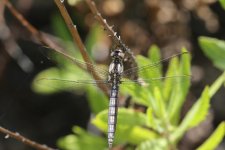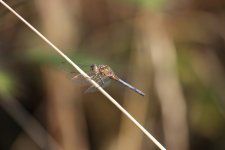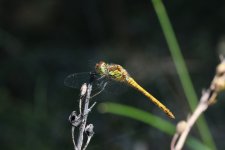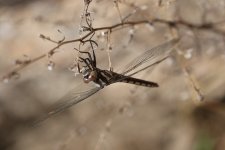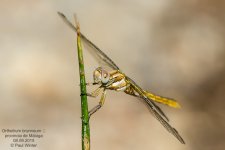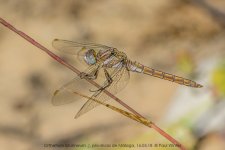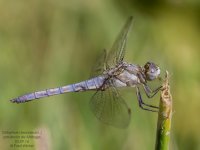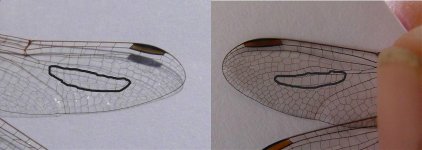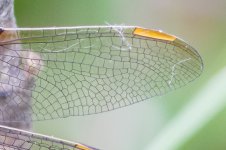Here are some skimmers and sympetrums. Thanks for looking, I hope you can identify these. Sardinia June 2018
-
Welcome to BirdForum, the internet's largest birding community with thousands of members from all over the world. The forums are dedicated to wild birds, birding, binoculars and equipment and all that goes with it.
Please register for an account to take part in the discussions in the forum, post your pictures in the gallery and more.
You are using an out of date browser. It may not display this or other websites correctly.
You should upgrade or use an alternative browser.
You should upgrade or use an alternative browser.
ID please Sardinia dragonflies (1 Viewer)
- Thread starter creedence
- Start date
More options
Who Replied?Phil Bishop
Well-known member
1. Keeled Skimmer
2. Common Darter
3.Keeled Skimmer I think
4. Red Veined I think
2. Common Darter
3.Keeled Skimmer I think
4. Red Veined I think
Andy Adcock
Worst person on Birdforum

Red-veined should have an obvious blue, lower half to the eyes.
It also has yellow tibia so Common Darter IMO?
A
It also has yellow tibia so Common Darter IMO?
A
Last edited:
Phil Bishop
Well-known member
Red-veined should have an obvious blue, lower half to the eyes.
It also has yellow tibia so Common Darter IMO?
A
Your right of course.
Interesting update
I was never happy with picture 1 being O. coerulescens and went through the pictures again. I found this one which shows the side of the thorax. This for me was quite a puzzle as it looks nothing like any other Orthetrum illustrated in Dijkstra. A continental friend pointed me in the right direction; it is O. brunneum! The site actually held O coerulescens, cancellatum and brunneum. Sorry for not providing this picture before, but perhaps I am not the only one to learn from this.
I was never happy with picture 1 being O. coerulescens and went through the pictures again. I found this one which shows the side of the thorax. This for me was quite a puzzle as it looks nothing like any other Orthetrum illustrated in Dijkstra. A continental friend pointed me in the right direction; it is O. brunneum! The site actually held O coerulescens, cancellatum and brunneum. Sorry for not providing this picture before, but perhaps I am not the only one to learn from this.
Attachments
pdwinter
Paul Winter
I was never happy with picture 1 being O. coerulescens and went through the pictures again. I found this one which shows the side of the thorax. This for me was quite a puzzle as it looks nothing like any other Orthetrum illustrated in Dijkstra. A continental friend pointed me in the right direction; it is O. brunneum! The site actually held O coerulescens, cancellatum and brunneum. Sorry for not providing this picture before, but perhaps I am not the only one to learn from this.
I somehow missed this thread
If Lewington illustrated Dijkstra with individuals of all ages then the book would be too big for us to carry in the field!
Attached an immature female Southern Skimmer (O.brunneum) from Spain in September 2015. As they get older they lose the shoulder stripes and so become less 'Keeled'-like.
Attachments
Andy Adcock
Worst person on Birdforum

Thanks again Paul. My example is a male. Interesting stuff!
We are having to wait a long time for the 2nd edition of Dijkstra, do you know if its coming soon? Two books, a paperback for the field and a heavy augmented edition for the desk would be ideal!
The book isn't that old, are they doing a 2nd Ed already?
pdwinter
Paul Winter
My example is a male.
So it is! I'm not being very observant lately - I looked at the small pterostigmas and the patterns and ignored the appendages. Two young males attached - one getting some pruinosity, the other not, and neither as dark as the one in your photo!
We are having to wait a long time for the 2nd edition of Dijkstra, do you know if its coming soon? Two books, a paperback for the field and a heavy augmented edition for the desk would be ideal!
14 May 2020 according to a google search."The second edition includes fully revised regional guides and identification texts, updated distribution maps and conservation statuses, illustrated accounts for five species that have been discovered in the region since the first edition, updated checklists and taxonomy, new photographs throughout, as well as an introduction to larvae identification. Each species is lavishly illustrated with artworks of males, females and variations, as well as close-ups of important characters."
I know Dave Smallshire is working on a European guide although I'm not sure when that is due for publication - it will be good to have a guide with photos as well as drawings.
New editions of both Britain's Dragonflies and Dragonflies & Damselflies of Great Britain and Ireland are due out over the next two months. Always good to spend the pension rather than save it!
Attachments
I was never happy with picture 1 being O. coerulescens and went through the pictures again. I found this one which shows the side of the thorax. This for me was quite a puzzle as it looks nothing like any other Orthetrum illustrated in Dijkstra. A continental friend pointed me in the right direction; it is O. brunneum! The site actually held O coerulescens, cancellatum and brunneum. Sorry for not providing this picture before, but perhaps I am not the only one to learn from this.
From my experience in Italy, the wing venation is the best separating characteristic between coerulescens and brunneum. Brunneum has a row of double cells below the Rspl (radial supplemental vein) while coerulescens has only the occasional doubled cell. You an see this on your first picture on the right forewing quite easily. Brunneum full males generally a more powdery baby blue than the purply blue (even on the thorax) of coerulescens towards the south of their range.
O
From my experience in Italy, the wing venation is the best separating characteristic between coerulescens and brunneum. Brunneum has a row of double cells below the Rspl (radial supplemental vein) while coerulescens has only the occasional doubled cell. You an see this on your first picture on the right forewing quite easily. Brunneum full males generally a more powdery baby blue than the purply blue (even on the thorax) of coerulescens towards the south of their range.
O
And the picture now I have found it: brunneum on the left, coerulescens on the right
O
Attachments
pdwinter
Paul Winter
From my experience in Italy, the wing venation is the best separating characteristic between coerulescens and brunneum. Brunneum has a row of double cells below the Rspl (radial supplemental vein) while coerulescens has only the occasional doubled cell. You an see this on your first picture on the right forewing quite easily. Brunneum full males generally a more powdery baby blue than the purply blue (even on the thorax) of coerulescens towards the south of their range.
O
Attached is a Keeled Skimmer from the Ober Water - 4 doubled cells! But of course that is an exception. I have looked through quite a few photos recently and the brunneum in my collection with the fewest doubled cells has three in the left wing and four in the right wing. My brunneum images otherwise have 4-7 doubled. I've seen an image of one with ten doubled cells.
Paul
Attachments
Users who are viewing this thread
Total: 2 (members: 0, guests: 2)




